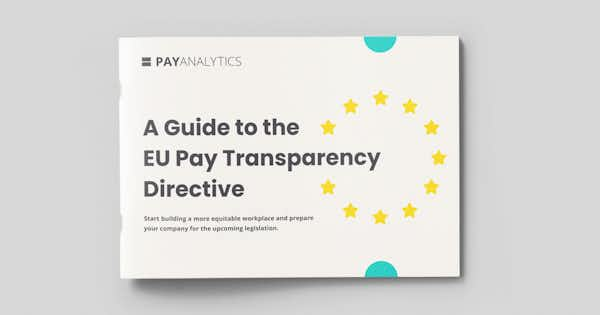Se préparer à la directive européenne sur la transparence salariale | Téléchargez gratuitement notre E-book
Mesurez

Analyse de l'équité salariale
L'équité salariale aide à clarifier les structures salariales en identifiant les facteurs de rémunération, ce qui permet de prendre des décisions éclairées et de progresser en toute confiance.
Aperçu de toutes les caractéristiques du produit
Atteignez vos objectifs en matière d'équité salariale grâce au logiciel PayAnalytics. Il est conçu pour vous permettre d'être opérationnel avec un minimum d'installation - soutenu par des tutoriels vidéo et une documentation digeste.
Analyse de l'équité salariale
Révélez les facteurs influençant la rémunération, prendre des décisions éclairées.
Comparaison selon la valeur
Comparez différents emplois selon le principe d'égalité de rémunération pour des travaux de valeur égale.
Analyse du personnel
Examinez et améliorez la diversité, orientez efficacement les efforts d'IED au sein de votre organisation.
Mesures correctives
Obtenez des recommandations personnalisées pour combler les écarts de rémunération, adaptées à vos besoins et à votre budget.
Rapports
Des outils essentiels pour la conformité globale et des rapports personnalisables pour la direction.
Assistant de rémunération
Contribuez à maintenir un lieu de travail exempt de préjugés en veillant à ce que les décisions en matière de rémunération soient judicieuses.
Gestion des données
Affinez facilement les données importées dans PayAnalytics en les corrigeant, en les éditant et en les ajoutant, afin de garantir leur exactitude et leur visibilité.
Évaluation des emplois
Créez des structures de rémunération objectives, comparez les différents rôles en fonction de la valeur de l'organisation.
Contrôles d'accès utilisateur
Contrôles d'accès précis, car les utilisateurs ont des besoins différents en matière d'accès aux données.

Êtes-vous prêt pour la directive européenne ? Nous avons préparé un guide pour vous aider à vous familiariser avec les nouvelles exigences.
Aperçu des ressources
Nous avons mis en place un centre de connaissances pour vous aider à naviguer dans tout ce qui concerne l'équité salariale, la DEI et l'analyse des effectifs. Vous y trouverez des articles, des livres électroniques téléchargeables, des podcasts et bien plus encore.
Guides et livres électroniques
Explorez nos guides pratiques qui vous donnent des conseils sur la réalisation de l'équité sur le lieu de travail. Ils se présentent sous la forme d'articles détaillés et d'e-books téléchargeables.
Articles et blogs
Restez informé sur l'équité salariale, la transparence, l'équité au travail, les stratégies de communication et les tendances actuelles.
Exigences locales
Restez au fait de l'évolution du paysage juridique et découvrez les réglementations qui peuvent s'appliquer à vous.
Cafés-rencontres de Planet Fair
Les dernières nouvelles sur l'équité salariale en seulement 8 minutes, un vendredi sur deux avec Margrét & Henrike.
Témoignages de nos clients
Découvrez comment des entreprises ont comblé l'écart salarial grâce à PayAnalytics.

PayAnalytics acquise par beqom
PayAnalytics a annoncé son acquisition par beqom, l'un des principaux fournisseurs de solutions de rémunération globale et de gestion de la performance.
À propos de PayAnalytics
Nous pensons que le salaire est plus qu'un chiffre. Notre logiciel est le fruit de plus d'une décennie de recherche et développement menés par des professeurs, des experts en équité salariale et des ingénieurs primés.
Offres d'emploi
Rejoignez notre équipe passionnée et hautement qualifiée. Nous sommes des pionniers dans notre domaine, aidant les entreprises à créer des lieux de travail équitables.
Actualités
Les dernières nouvelles de l'entreprise, telles que les événements, les nouvelles des clients, les communiqués de presse et bien plus encore.
Marque
Découvrez notre marque, nos récompenses et notre histoire. Vous trouverez ici des actifs de marque et des photos pour télécharger.
Partenariats
Nous travaillons avec divers partenaires pour promouvoir la transparence et l'équité dans les pratiques salariales. Découvrez les possibilités de partenariat.
Services de conseil
Services de conseil personnalisés pour la mise en œuvre de l’équité salariale, conçus pour compléter et renforcer l’utilisation de notre logiciel.
Aperçu de toutes les caractéristiques du produit
Atteignez vos objectifs en matière d'équité salariale grâce au logiciel PayAnalytics. Il est conçu pour vous permettre d'être opérationnel avec un minimum d'installation - soutenu par des tutoriels vidéo et une documentation digeste.
Analyse de l'équité salariale
Révélez les facteurs influençant la rémunération, prendre des décisions éclairées.
Comparaison selon la valeur
Comparez différents emplois selon le principe d'égalité de rémunération pour des travaux de valeur égale.
Analyse du personnel
Examinez et améliorez la diversité, orientez efficacement les efforts d'IED au sein de votre organisation.
Mesures correctives
Obtenez des recommandations personnalisées pour combler les écarts de rémunération, adaptées à vos besoins et à votre budget.
Rapports
Des outils essentiels pour la conformité globale et des rapports personnalisables pour la direction.
Assistant de rémunération
Contribuez à maintenir un lieu de travail exempt de préjugés en veillant à ce que les décisions en matière de rémunération soient judicieuses.
Gestion des données
Affinez facilement les données importées dans PayAnalytics en les corrigeant, en les éditant et en les ajoutant, afin de garantir leur exactitude et leur visibilité.
Évaluation des emplois
Créez des structures de rémunération objectives, comparez les différents rôles en fonction de la valeur de l'organisation.
Contrôles d'accès utilisateur
Contrôles d'accès précis, car les utilisateurs ont des besoins différents en matière d'accès aux données.
Aperçu des ressources
Nous avons mis en place un centre de connaissances pour vous aider à naviguer dans tout ce qui concerne l'équité salariale, la DEI et l'analyse des effectifs. Vous y trouverez des articles, des livres électroniques téléchargeables, des podcasts et bien plus encore.
Guides et livres électroniques
Explorez nos guides pratiques qui vous donnent des conseils sur la réalisation de l'équité sur le lieu de travail. Ils se présentent sous la forme d'articles détaillés et d'e-books téléchargeables.
Articles et blogs
Restez informé sur l'équité salariale, la transparence, l'équité au travail, les stratégies de communication et les tendances actuelles.
Exigences locales
Restez au fait de l'évolution du paysage juridique et découvrez les réglementations qui peuvent s'appliquer à vous.
Cafés-rencontres de Planet Fair
Les dernières nouvelles sur l'équité salariale en seulement 8 minutes, un vendredi sur deux avec Margrét & Henrike.
Témoignages de nos clients
Découvrez comment des entreprises ont comblé l'écart salarial grâce à PayAnalytics.
À propos de PayAnalytics
Nous pensons que le salaire est plus qu'un chiffre. Notre logiciel est le fruit de plus d'une décennie de recherche et développement menés par des professeurs, des experts en équité salariale et des ingénieurs primés.
Offres d'emploi
Rejoignez notre équipe passionnée et hautement qualifiée. Nous sommes des pionniers dans notre domaine, aidant les entreprises à créer des lieux de travail équitables.
Actualités
Les dernières nouvelles de l'entreprise, telles que les événements, les nouvelles des clients, les communiqués de presse et bien plus encore.
Marque
Découvrez notre marque, nos récompenses et notre histoire. Vous trouverez ici des actifs de marque et des photos pour télécharger.
Partenariats
Nous travaillons avec divers partenaires pour promouvoir la transparence et l'équité dans les pratiques salariales. Découvrez les possibilités de partenariat.
Services de conseil
Services de conseil personnalisés pour la mise en œuvre de l’équité salariale, conçus pour compléter et renforcer l’utilisation de notre logiciel.

- Accueil
- Ressources
- Articles
Articles et blogs
Vous trouverez ici une collection complète d'articles consacrés à la promotion de l'équité sur le lieu de travail, de la transparence salariale et des pratiques en matière de diversité, d'équité et d'inclusion (DEI). Qu'il s'agisse de conseils pratiques pour s'y retrouver dans les lois sur l'équité salariale en vigueur dans différents pays, d'analyses approfondies sur le calcul des écarts salariaux entre hommes et femmes ou des avantages des pratiques salariales équitables pour attirer et retenir les talents, nos ressources sont conçues pour soutenir les organisations et les personnes qui s'engagent à réaliser des progrès significatifs en matière d'égalité sur le lieu de travail.
- Article
Over the last several years, Portugal has strengthened its pay equity laws. They emphasize transparency, and employers with gender pay gaps may be asked to create a pay equity evaluation plan. This short article provides information to help employers in Portugal be prepared and proactive.
- Article
Japan has the largest gender pay gap of any G7 nation. To promote workplace equality, keep women in the labor force after childbirth, and increase advancement opportunities, the country recently made changes to its pay gap reporting requirements.
- Article
PayAnalytics’ new Workplace Equity feature helps organizations move beyond equity in pay alone. This feature helps companies analyze diversity and representation among current employees, new hires, and employees who exit the organization, and it looks for demographic differences in who receives raises and promotions.
- Article
- Équité salariale
In 2023, Washington State expanded its pay transparency requirements by creating the Equal Pay and Opportunities Act (EPOA). Rather than disclosing a job’s minimum pay when making an applicant a job offer, the EPOA requires employers to disclose pay ranges in the job posting. In 2025, an amendment was passed to give employers a short window to correct noncompliant postings, to reduce statutory damages for noncompliance, and to clarify the wage information required in postings.
- Article
In summer 2022, Ireland implemented a far-reaching pay equity legislation, the Gender Pay Gap Information Act 2021. This legislation requires employers to begin reporting on their gender pay gaps. Companies will need to report differences in the mean and median pay between male and female employees. And if there’s a pay disparity, the company will need to provide a written explanation for it and outline any steps planned to close the gap.
- Article
As pay transparency laws continue to gain traction across the US, California employers are getting ready to comply with the state’s new pay reporting and pay disclosure law. It was signed by Governor Newsom on September 27, 2022.
- Article
PayAnalytics looks back on a productive 2022. We rolled out several new features to support customers on their pay equity journeys, and we celebrated big milestones for several of our customers. In addition, our team presented at conferences and published their research to promote pay equity worldwide.
- Article
Companies hiring in New York City have been changing the way they advertise job openings in response to the new pay transparency law. The New York City pay transparency law's effective date was November 1, 2022, and since then, companies with four or more employees must post the pay range for every job posting. The law covers all NYC-based companies. It also covers companies beyond city limits posting remote jobs that may be filled by NYC-based workers.
- Article
Les écarts salariaux démographiques constituent aujourd'hui un problème croissant, les organisations et les gouvernements cherchant des solutions pour garantir l'égalité salariale. Deux notions sont régulièrement appelées « l'écart salarial ». Quelle est la différence entre l'écart salarial ajusté et l'écart salarial non ajusté ?
- Article
Chez PayAnalytics, nous parlons souvent d’égalité salariale pour des travaux de valeur égale. La Loi sur l’équité salariale du Canada, entrée en vigueur août 2021, adopte une approche unique pour atteindre cet objectif. Généralement, les exigences en matière d’équité salariale se concentrent sur la rémunération des hommes et des femmes réalisant un travail similaire, mais le Canada se concentre désormais sur la valeur de l’emploi pour l’employeur.
- Article
Last week, our founders David Anderson and Margret Bjarnadottir presented their academic work at the WorldatWork Workplace Equity Forum 2022 in Austin, Texas.
- Article
"With the right tools, supported with the right data, we can bring about workplace transformation and pay equity."
In the latest issue of Dynamic Magazine, our founder Margrét shares valuable insights for leaders using data analytics or AI on their pay equity journeys.
Inscrivez-vous à notre Newsletter
Notre newsletter couvre des sujets tels que l'équité salariale, la rémunération et les avantages sociaux, la diversité, l'équité et l'inclusion (DEI) et les changements législatifs, ainsi que des nouvelles de notre entreprise et des mises à jour de notre logiciel.











